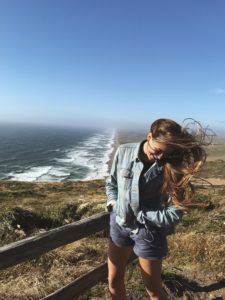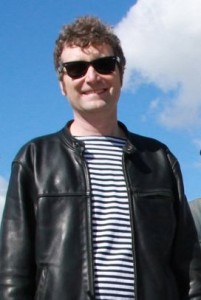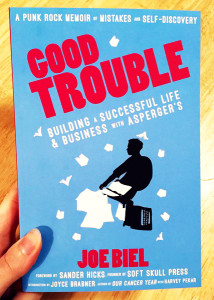Meet the Remote Interns!

Microcosm has three seasonal internship opportunities per year, each for multiple interns. Due to the pandemic, the current internship is completely virtual! Here’s some info about the newest members of our team: Alana Baldwin-Joiner (she/her), Eli Humphrey (he/they), Ella Mankowski (she/her), and Michael Quinn (they/them).
Where are you from/ where did you grow up?
Alana: Hillsboro, Oregon!
Eli: I grew up in Denver, Colorado.
Ella: Born and raised in Portland, Oregon!
Michael: I grew up all throughout New York.

What first got you interested in publishing?
Alana: I was the copyeditor for my high school’s yearbook, and I always enjoyed editing my friends’ writing, so I thought it would be a career I would really enjoy. Plus I’ve always adored the idea of helping authors make their dreams of being published come true!
Eli: I studied writing in middle/highschool and put together a chapbook of my work. The experience got me interested in local zines and the publishing process.
Ella: I’ve always had an affinity for language. I was assistant editor for my high school newspaper for about a year and I really enjoyed the process of publishing that.
Michael: Books are something that changed my life for the better, and I feel like there’s so many important stories that haven’t been told yet!
What’s your favorite Microcosm book/ a Microcosm book you’d really like to read?
Alana: My favorite so far is Teenage Castaways, a zine I got to edit! I also had a lot of fun working with Bikes in Space with Cats, it’s darn plum cute.
Eli: My favorite at the moment is Coping Skills: Tools and Techniques for Every Stressful Situation. Dr. Faith G. Harper is fantastic. It’s like therapy with lots of swearing!
Ella: There are so many! I think my favorite Microcosm book that I’ve read so far is Do Not Pet: A Service Dog’s Graphic Tail by Joe Biel. I’m looking forward to the upcoming WLW sci-fi and fantasy erotica anthology that’s part of the Queering Consent series. I’d really like to get my hands on a copy of Practical Witch’s Almanac 2021: Crafting Your Magic.
Michael: I’ve currently got Scam: The First Four Issues by Erica Dawn Lyle sitting next to me – Scam was extremely influential on both zine culture and punk culture so I’m super excited to dig into it. Next up is Rock and Roll Terrorist: The Graphic Life of Shock Rocker GG Allin – GG Allin is polarizing and undeniably a punk rock anti-hero, but his life and career is fascinating and he made some great music!

How’s the pandemic treating you?
Alana: It’s been a wild ride! Because of the pandemic making all but one of my jobs remote, I’ve been able to work 4 jobs while I go to school, which is nifty. But it’s also been stressful, with lots of moving and too much computer screen time. I live with my partner and our monster of a cat, so I’m lucky to not be alone at least!
Eli: I’m living with my partner and a friend, so fortunately I haven’t been entirely on my own through all of this. Over the course of 2020, I also made an effort to reconnect with some of my old creativity (finally shaken off years of writer’s block).
Ella: It’s been crazy. I’m really lucky that I can safely see my girlfriend. I decided to take a gap year, so this internship is a great way for me to keep myself busy and develop new skills while still having a good time.
Michael: It’s been interesting to say the least! The last 10 months have felt like a lifetime – I’ve spent the vast majority of it documenting protests and speaking to people involved. It’s definitely helped keep me motivated, excited and hopeful throughout everything.
Do you have any pets?
Alana: I have a very round and very moody cat named Aurora!
Eli: I have a cat named Ozzy and a fish named Hades. The cat spends hours staring at the fish, but we have yet to have a serious incident.
Ella: I’ve got a cat named Willow, a dog named Rose, and three chickens— Pansy, Roxy, and Semolina.
Michael: I don’t, but my roommates have 2 cats: Moop and Tiny Cat.

What do you do in your free time?
Alana: I’ve been trying to watch new Netflix shows lately! I just finished Schitt’s Creek and Sweet Magnolias, which is a big accomplishment for a repeat-binger like me!
Eli: I’ve been watching movies and trying to catch up on books I’ve wanted to read for ages. I don’t know if this necessarily counts as free time, but I’m about to start classes at PNCA!
Ella: Recently I’ve been listening to podcasts— Ologies with Alie Ward is a new favorite of mine. I also like to draw, design houses, and play video games, and I love learning how to make new things!
Michael: Most of the time, I’m either programming, documenting a protest, filing FOIA requests so we can learn more about how the government works, or going on bike rides while blasting some Against Me!
What’s one piece of media you’d recommend to anyone and everyone?
Alana: Schitt’s Creek, for sure! Hilarious, heartwarming, and the first time I’ve had my sexuality represented on screen without homophobia, it’s amazing.
Eli: My favorite film right now is called Down By Law by Jim Jarmusch. It’s a pretty simple story about three men who get arrested and taken to jail. Two of them were framed by the New Orleans Police Department. Tom Waits, the stunning John Lurie, and a surprisingly incredible Roberto Benigni.
Ella: Coyote Doggirl by Lisa Hanawalt is fantastic. Beautiful art, fantastic storytelling, and tells a powerful story about sexual assault. Also, who doesn’t love a pink coyote-dog cowgirl (who designs and makes her own clothes!)?
Michael: This is a super hard choice, but I think I’d have to go with Nevada by Imogen Binnie. It’s a gritty, relatively dark coming of age story that I think will hit extremely close to home for anyone queer and help educate allies. Bring a box of tissues and be prepared to read it in one sitting though!
Where can people find you online?
Alana: My Instagram is @alana.baldwin.joiner (not frequently updated, but I am on there!)
Eli: My (mostly) writing Instagram is @eli_jhumphrey. Expect occasional photos of my partner and our kitten.
Ella: My art Instagram is @dappled_doodler. My girlfriend and I also have a joint art Instagram @hellarm.art.
Michael: I’ve never been a social media person really, but you can find me, my writing and research at FallingThruWindows.net whenever I get that back online.

 A couple of months ago I was lucky enough to be accepted as a summer intern at Microcosm Publishing. I’m from California, which meant that I would be spending the summer moving to a brand new city completely separate from my family, friends, and basically everything I know. I won’t say that this wasn’t a little scary; it was. But the opportunity was far too great to pass up. So I moved up the coast and settled myself into the City of Roses.
A couple of months ago I was lucky enough to be accepted as a summer intern at Microcosm Publishing. I’m from California, which meant that I would be spending the summer moving to a brand new city completely separate from my family, friends, and basically everything I know. I won’t say that this wasn’t a little scary; it was. But the opportunity was far too great to pass up. So I moved up the coast and settled myself into the City of Roses.






 Our newest staff person is editorial and marketing assistant Tomy Huynh! Tomy (his name is pronounced as though it’s spelled Tommy) manages our data, which despite his modest description is a huge and daunting multi-faceted task full of highly contingent details which few people, no matter how brilliant, are able to wrap their brains around.
Our newest staff person is editorial and marketing assistant Tomy Huynh! Tomy (his name is pronounced as though it’s spelled Tommy) manages our data, which despite his modest description is a huge and daunting multi-faceted task full of highly contingent details which few people, no matter how brilliant, are able to wrap their brains around. 
 We’re stoked to announce the official publication of
We’re stoked to announce the official publication of
 4. What’s your next project that you’re most excited about?
4. What’s your next project that you’re most excited about?
 Thank you. I would like to believe that I’m cautious about everything but most of the rest of the staff would probably disagree. In prehistoric times, a memoir was simply a story. If we’re using marketing terms, a memoir could simply be a nonfiction novel. But a novel has a narrative, characters, plot, a theme, and an arc. Many writers don’t engage the reader as a stakeholder in their writing and many of the memoirs that are submitted to us are expected to be published on the grounds that they have been written. For a memoir to work, it needs to have all of those components and have a clear concept of what it is, who it is for, and how it is different from the pack. My book is for would-be publishers, adult autistics, Microcosm fans, and people who want to start businesses. There needs to be at least 5,000 of these people out there and we need to know how to reach them. I am too close to the work to tell you if mine succeeds but thankfully everyone who I have heard from so far has enjoyed it immensely so I am thankful that I have good editors and that I put so many hours into it.
Thank you. I would like to believe that I’m cautious about everything but most of the rest of the staff would probably disagree. In prehistoric times, a memoir was simply a story. If we’re using marketing terms, a memoir could simply be a nonfiction novel. But a novel has a narrative, characters, plot, a theme, and an arc. Many writers don’t engage the reader as a stakeholder in their writing and many of the memoirs that are submitted to us are expected to be published on the grounds that they have been written. For a memoir to work, it needs to have all of those components and have a clear concept of what it is, who it is for, and how it is different from the pack. My book is for would-be publishers, adult autistics, Microcosm fans, and people who want to start businesses. There needs to be at least 5,000 of these people out there and we need to know how to reach them. I am too close to the work to tell you if mine succeeds but thankfully everyone who I have heard from so far has enjoyed it immensely so I am thankful that I have good editors and that I put so many hours into it.




 1. What do you do at Microcosm? What parts of the work you do here (and used to do as an intern) are the most entertaining?
1. What do you do at Microcosm? What parts of the work you do here (and used to do as an intern) are the most entertaining? 4. Favorites!
4. Favorites! A big welcome to our newest Microcosm worker, sales director Thea Kuticka. Thea has been here for a month, getting to know our systems (aka, epic wading through lots and lots of spreadsheets), getting acquainted with everyone, and sharing her experience and insights from over a decade in publishing (and also her home grown blackberries, yum!). I asked her some questions over email.
A big welcome to our newest Microcosm worker, sales director Thea Kuticka. Thea has been here for a month, getting to know our systems (aka, epic wading through lots and lots of spreadsheets), getting acquainted with everyone, and sharing her experience and insights from over a decade in publishing (and also her home grown blackberries, yum!). I asked her some questions over email. My favorite kind of book to read is one that will inspire me creatively. I look for stories that come from a creative impulse. These are inspired novels and memoirs such as
My favorite kind of book to read is one that will inspire me creatively. I look for stories that come from a creative impulse. These are inspired novels and memoirs such as  I’m optimistic! And this is coming from someone who tends to see the glass half empty. The desire to read is as strong as ever—it’s just how we read and the tools we use to access those ideas that have changed. It used to be TV that would kill the book, then it was gaming, now it’s ebooks. But what hasn’t changed is our insatiable need for more—we still want to be entertained, inspired, discovered—there’s a huge collaboration going on now between readers and publishers.
I’m optimistic! And this is coming from someone who tends to see the glass half empty. The desire to read is as strong as ever—it’s just how we read and the tools we use to access those ideas that have changed. It used to be TV that would kill the book, then it was gaming, now it’s ebooks. But what hasn’t changed is our insatiable need for more—we still want to be entertained, inspired, discovered—there’s a huge collaboration going on now between readers and publishers.  If you call or visit
If you call or visit